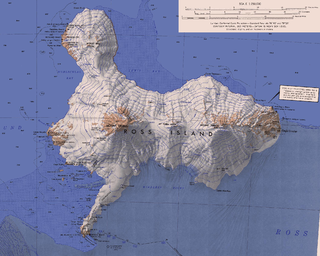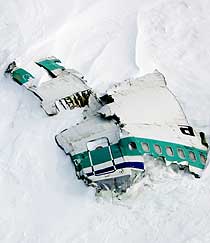
Cyclops is a fictional character, a superhero appearing in American comic books published by Marvel Comics and is a founding member of the X-Men. Created by writer Stan Lee and artist/co-plotter Jack Kirby, the character first appeared in the comic book The X-Men. Cyclops is a member of a subspecies of humans known as mutants, who are born with superhuman abilities. Cyclops emits powerful beams of energy from his eyes, and can only control the beams with the aid of special eyewear which he must wear at all times. He is typically considered the first of the X-Men, a team of mutant heroes who fight for peace and equality between mutants and humans, and one of the team's primary leaders.
In Greek mythology and Roman mythology, Erebus, or Erebos, is the personification of darkness and one of the primordial deities. Hesiod's Theogony identifies him as one of the first five beings in existence, born of Chaos.

Ross Island is an island formed by four volcanoes in the Ross Sea near the continent of Antarctica, off the coast of Victoria Land in McMurdo Sound. Ross Island lies within the boundaries of Ross Dependency, an area of Antarctica claimed by New Zealand.

Mount Erebus is the second-highest volcano in Antarctica, the highest active volcano in Antarctica, and the southernmost active volcano on Earth. It is the sixth-highest ultra mountain on the continent. With a summit elevation of 3,794 metres (12,448 ft), it is located in the Ross Dependency on Ross Island, which is also home to three inactive volcanoes: Mount Terror, Mount Bird, and Mount Terra Nova.

HMS Erebus was a Hecla-class bomb vessel constructed by the Royal Navy in Pembroke dockyard, Wales, in 1826. The vessel was the second in the Royal Navy named after Erebus, the personification of darkness in Greek mythology.

The Mount Erebus disaster occurred on 28 November 1979 when Air New Zealand Flight 901 (TE-901) flew into Mount Erebus on Ross Island, Antarctica, killing all 237 passengers and 20 crew on board. Air New Zealand had been operating scheduled Antarctic sightseeing flights since 1977. This flight was supposed to leave Auckland Airport in the morning and spend a few hours flying over the Antarctic continent, before returning to Auckland in the evening via Christchurch.

USS Cyclops (AC-4) was the second of four Proteus-class colliers built for the United States Navy several years before World War I. Named after the Cyclops, a race of giants from Greek mythology, she was the second U.S. Naval vessel to bear the name. The loss of the ship and 306 crew and passengers without a trace some time after 4 March 1918 remains the single largest loss of life in the history of the United States Navy not directly involving combat. As the loss occurred during World War I, she was thought to have been captured or sunk by a German raider or submarine, because she was carrying 10,800 long tons (11,000 t) of manganese ore used to produce munitions, but German authorities at the time, and subsequently, denied any knowledge of the vessel. The Naval History & Heritage Command has stated she "probably sank in an unexpected storm", but the cause of the ship's loss is not known.

The Erebus class of warships was a class of 20th century Royal Navy monitors armed with a main battery of two 15-inch /42 Mk 1 guns in a single turret. It consisted of two vessels, Erebus and Terror, named after the two ships lost in the Franklin Expedition. Both were launched in 1916 and saw active service in World War I off the Belgian coast. After being placed in reserve between the wars, they served in World War II, with Terror being lost in 1941 and Erebus surviving to be scrapped in 1946.

HMS Terror was a specialised warship and a newly developed bomb vessel constructed for the Royal Navy in 1813. She participated in several battles of the War of 1812, including the Battle of Baltimore with the bombardment of Fort McHenry. She was converted into a polar exploration ship two decades later, and participated in George Back's Arctic expedition of 1836–1837, the successful Ross expedition to the Antarctic of 1839 to 1843, and Sir John Franklin's ill-fated attempt to force the Northwest Passage in 1845, during which she was lost with all hands along with HMS Erebus.

Cyclops is an ancient Greek satyr play by Euripides, based closely on an episode from the Odyssey. It would have been the fourth part of a tetralogy presented by Euripides in a dramatic festival in 5th Century BC Athens. The date of its composition is unknown, but it was probably written late in Euripides' career. It is the only complete satyr play extant. It is one of a double bill in the 2022 Cambridge Greek Play.

The Lower Erebus Hut (LEH) is a permanent field facility located on Mount Erebus on Ross Island, Antarctica. The hut served as the seasonal base of the Mount Erebus Volcano Observatory (MEVO), run by New Mexico Institute of Mining and Technology (NMT). The installation comprises two huts, one kitchen and recreation building and one working and storage building.

The Erebus Ice Tongue is a mountain outlet glacier and the seaward extension of Erebus Glacier from Ross Island. It projects 11 kilometres (6.8 mi) into McMurdo Sound from the Ross Island coastline near Cape Evans, Antarctica. The glacier tongue varies in thickness from 50 metres (160 ft) at the snout to 300 metres (980 ft) at the point where it is grounded on the shoreline. Explorers from Robert F. Scott's Discovery Expedition (1901–1904) named and charted the ice tongue.
Cyclops is one of the only X-Men to be featured in every adaptation of the series. This is a list of all media appearances of the Marvel Comics character Cyclops.

Erebus is a genus of moths in the family Erebidae.

Erebus Montes is a group of mountains in the Diacria quadrangle of Mars, located at 35.66° North and 185.02° West. It is 811 km across and was named after an albedo feature at 26N, 182W.

Erebus crepuscularis is a moth of the family Erebidae first described by Carl Linnaeus in his 1758 10th edition of Systema Naturae. It is found in Indonesia, New Guinea, Taiwan and the Australian states of Queensland and New South Wales.
Erebus Glacier is a glacier draining the lower southern slopes of Mount Erebus, Ross Island, Antarctica. It flows west to Erebus Bay where it forms the floating Erebus Glacier Tongue. It was named in association with Mount Erebus by the British National Antarctic Expedition, 1901–04, under Robert Falcon Scott.

Mount Terra Nova is a snow-covered inactive volcanic mountain, 2,130 m (6,990 ft), between Mount Erebus and Mount Terror on Ross Island. It was first mapped by the Discovery expedition in 1901–04, and named for Terra Nova, the relief ship for this expedition and the British Antarctic Expedition, 1910–13.

HMS Cyclops was a paddle wheel steam frigate built for the Royal Navy and launched in 1839 and taken out of service in 1861 and sold for breaking in January 1864. She saw action in the Syrian War in 1840 and the Crimean War in 1854, later being involved in laying the first Transatlantic telegraph cable in 1858.














